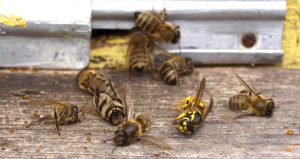20
Sep
Study Finds Bee Colonies Die-off as the Number of Different Pesticide Exposures Increase
(Beyond Pesticides, September 20, 2016) Honey bee colonies are declining as the total number of pesticide products they are exposed to increases, regardless of the amount of exposure, according to research published last week from scientists at the University of Maryland (UMD). The study aimed to look at honey bee colonies’ exposome, a term traditionally used in cancer research, defined as the measure of all exposures over an individual’s lifetime and how those exposures relate to health. In their investigation, researchers did not look at individual honey bees but instead treated the colony as a single super-organism, and based results on lifetime exposure to agricultural chemicals.
 The 91 honey bee colonies studied by researchers were exposed to a total of 93 different pesticide compounds throughout the course of their pollination season. Of these residues, 13 different compounds were found in bees, 61 in beebread (packed pollen within the hive), and 70 were found in wax. Researchers gauged the effect of pesticide exposure not only by looking at the number of pesticides in colonies, but also their toxicological relevance over a specific threshold, as well as through the calculation of a hazard quotient (HQ), which evaluates the cumulative toxicity of various pesticide residues. Pesticide detections and HQ spiked when colonies were placed in agricultural fields for pollination (including blueberry, apple, citrus and cucumber production), and decreased when placed in a holding yard or put into honey production.
The 91 honey bee colonies studied by researchers were exposed to a total of 93 different pesticide compounds throughout the course of their pollination season. Of these residues, 13 different compounds were found in bees, 61 in beebread (packed pollen within the hive), and 70 were found in wax. Researchers gauged the effect of pesticide exposure not only by looking at the number of pesticides in colonies, but also their toxicological relevance over a specific threshold, as well as through the calculation of a hazard quotient (HQ), which evaluates the cumulative toxicity of various pesticide residues. Pesticide detections and HQ spiked when colonies were placed in agricultural fields for pollination (including blueberry, apple, citrus and cucumber production), and decreased when placed in a holding yard or put into honey production.
During the pollination season, colonies that died-off had higher total pesticide residues in their wax over the course of sampling than colonies that survived. While researchers found that insecticides were the greatest contributor of increased hazard to honey bee colonies, elevated levels of fungicides appeared to be correlated with colonies that died within ~30 days after sampling. “We were surprised to find such an abundance of fungicides inside the hives, but it was even more surprising to find that fungicides are linked to imminent colony mortality,” said Kirsten Traynor, PhD, a postdoctoral researcher in entomology at UMD and lead author on the study. “These compounds have long been thought to be safe for bees. We’re seeing them at higher doses than the chemicals beekeepers apply directly to the colonies to control varroa mites. So that is particularly concerning.”
Pesticide load and hazard were also elevated in colonies that experienced a queen event —when a queen is replaced, in the process of being replaced, or queenless. A queen event is a predictor that a colony will die-off within ~50 days. Researchers found levels of synthetic pyrethroids were higher in colonies with a queen event, echoing past research showing adverse effects to bee reproduction from pyrethroid exposure. While scientists did not find a significant contribution from neonicotinoids, a class of chemicals widely implicated in bee and other pollinator declines, co-authors of the research note the study may not have been set up to adequately investigate their impact.
“We just did not find neonicotinoids in the colonies,” said Dennis vanEngelsdorp, PhD, UMD professor and co-author of the study. “There were some trace residues of neonicotinoids in a few samples, but not nearly on par with other compounds. However, it’s possible we did not test the right matrix””we did not test nectar, for example””or that the product breaks down faster than others in the collection process or that neonicotinoids are simply not very prevalent when crops are flowering.” Environmental and beekeeper groups have criticized Dr. vanEnglesdorp in the past for pinning the worldwide decline of honey bees on the varroa mite, and downplaying the role that neonicotinoid pesticides play in pollinator die-offs.
The implications of this research stretch beyond a single class of chemicals. While the body of science on neonicotinoids, including EPA’s own determination that these chemicals are highly toxic to bees, indicates that they should be immediately removed from use, it is evident that chemcial-intensive agriculture in general is owed much of the blame. Rather than focus on reducing pesticide exposure or refraining from use when bees are present, agrichemical companies, the conventional farming community, and federal regulators must take a long look at what practices are truly sustainable in the long term. It is clear that insect pollination and its subsequent health and economic benefits will not be maintained if measures aren’t taken to drastically shift agricultural production toward safer practices modeled on organic agriculture. By focusing on soil health, biodiversity, cultural practices like crop rotation and intercropping, and limited off-farm inputs, organic systems represent a viable, scalable path forward.
Concerned residents can help facilitate the shift to organic practices right in their own community by encouraging their local leaders to transition from conventional to organic landscaping. Individuals in farming communities can start conversations about safer practices directly with their neighbors and at community meetings. Consumers can help promote the growth of organic agriculture by purchasing organic products whenever possible. For more information on how organic agriculture benefits pollinators, see our BEE Protective and organic program webpage.
All unattributed positions and opinions in this piece are those of Beyond Pesticides.










